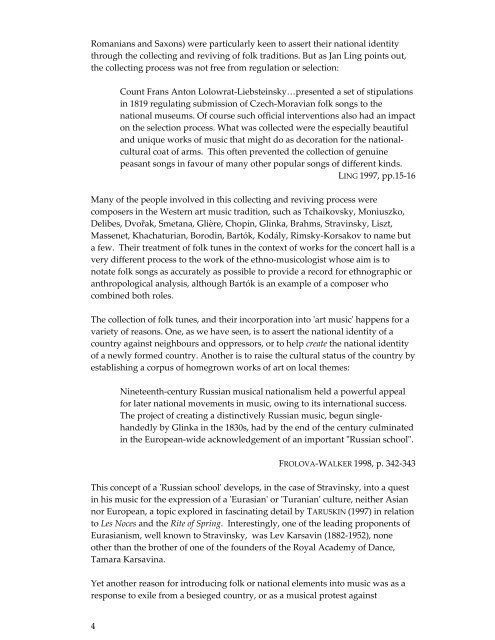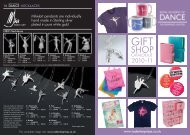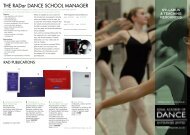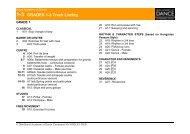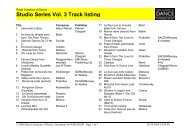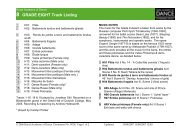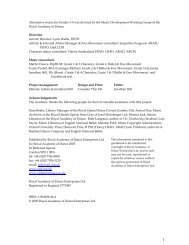Music in Focus guidebook to Alternative Music for Grades 1-3
Music in Focus guidebook to Alternative Music for Grades 1-3
Music in Focus guidebook to Alternative Music for Grades 1-3
Create successful ePaper yourself
Turn your PDF publications into a flip-book with our unique Google optimized e-Paper software.
Romanians and Saxons) were particularly keen <strong>to</strong> assert their national identity<br />
through the collect<strong>in</strong>g and reviv<strong>in</strong>g of folk traditions. But as Jan L<strong>in</strong>g po<strong>in</strong>ts out,<br />
the collect<strong>in</strong>g process was not free from regulation or selection:<br />
4<br />
Count Frans An<strong>to</strong>n Lolowrat‐Liebste<strong>in</strong>sky…presented a set of stipulations<br />
<strong>in</strong> 1819 regulat<strong>in</strong>g submission of Czech‐Moravian folk songs <strong>to</strong> the<br />
national museums. Of course such official <strong>in</strong>terventions also had an impact<br />
on the selection process. What was collected were the especially beautiful<br />
and unique works of music that might do as decoration <strong>for</strong> the national‐<br />
cultural coat of arms. This often prevented the collection of genu<strong>in</strong>e<br />
peasant songs <strong>in</strong> favour of many other popular songs of different k<strong>in</strong>ds.<br />
LING 1997, pp.15‐16<br />
Many of the people <strong>in</strong>volved <strong>in</strong> this collect<strong>in</strong>g and reviv<strong>in</strong>g process were<br />
composers <strong>in</strong> the Western art music tradition, such as Tchaikovsky, Moniuszko,<br />
Delibes, Dvořak, Smetana, Glière, Chop<strong>in</strong>, Gl<strong>in</strong>ka, Brahms, Strav<strong>in</strong>sky, Liszt,<br />
Massenet, Khachaturian, Borod<strong>in</strong>, Bartók, Kodály, Rimsky‐Korsakov <strong>to</strong> name but<br />
a few. Their treatment of folk tunes <strong>in</strong> the context of works <strong>for</strong> the concert hall is a<br />
very different process <strong>to</strong> the work of the ethno‐musicologist whose aim is <strong>to</strong><br />
notate folk songs as accurately as possible <strong>to</strong> provide a record <strong>for</strong> ethnographic or<br />
anthropological analysis, although Bartók is an example of a composer who<br />
comb<strong>in</strong>ed both roles.<br />
The collection of folk tunes, and their <strong>in</strong>corporation <strong>in</strong><strong>to</strong> ʹart musicʹ happens <strong>for</strong> a<br />
variety of reasons. One, as we have seen, is <strong>to</strong> assert the national identity of a<br />
country aga<strong>in</strong>st neighbours and oppressors, or <strong>to</strong> help create the national identity<br />
of a newly <strong>for</strong>med country. Another is <strong>to</strong> raise the cultural status of the country by<br />
establish<strong>in</strong>g a corpus of homegrown works of art on local themes:<br />
N<strong>in</strong>eteenth‐century Russian musical nationalism held a powerful appeal<br />
<strong>for</strong> later national movements <strong>in</strong> music, ow<strong>in</strong>g <strong>to</strong> its <strong>in</strong>ternational success.<br />
The project of creat<strong>in</strong>g a dist<strong>in</strong>ctively Russian music, begun s<strong>in</strong>gle‐<br />
handedly by Gl<strong>in</strong>ka <strong>in</strong> the 1830s, had by the end of the century culm<strong>in</strong>ated<br />
<strong>in</strong> the European‐wide acknowledgement of an important ʺRussian schoolʺ.<br />
FROLOVA‐WALKER 1998, p. 342‐343<br />
This concept of a ʹRussian schoolʹ develops, <strong>in</strong> the case of Strav<strong>in</strong>sky, <strong>in</strong><strong>to</strong> a quest<br />
<strong>in</strong> his music <strong>for</strong> the expression of a ʹEurasianʹ or ʹTuranianʹ culture, neither Asian<br />
nor European, a <strong>to</strong>pic explored <strong>in</strong> fasc<strong>in</strong>at<strong>in</strong>g detail by TARUSKIN (1997) <strong>in</strong> relation<br />
<strong>to</strong> Les Noces and the Rite of Spr<strong>in</strong>g. Interest<strong>in</strong>gly, one of the lead<strong>in</strong>g proponents of<br />
Eurasianism, well known <strong>to</strong> Strav<strong>in</strong>sky, was Lev Karsav<strong>in</strong> (1882‐1952), none<br />
other than the brother of one of the founders of the Royal Academy of Dance,<br />
Tamara Karsav<strong>in</strong>a.<br />
Yet another reason <strong>for</strong> <strong>in</strong>troduc<strong>in</strong>g folk or national elements <strong>in</strong><strong>to</strong> music was as a<br />
response <strong>to</strong> exile from a besieged country, or as a musical protest aga<strong>in</strong>st


